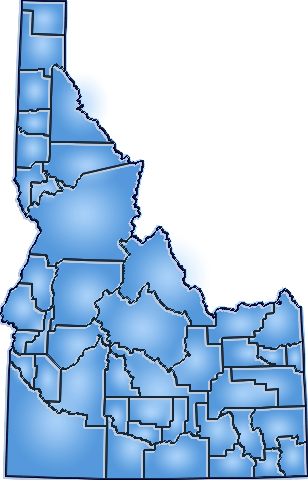Oneida County vs. Idaho Comparative Trends Analysis: Total Personal Income Growth and Change, 1969-2022 Introduction  Oneida County: 2022 TPI = $220,047K 2022 Percent of State = 0.20% Idaho: 2022 TPI = $109,775,862K 2022 Percent of U.S. = 0.50% The annual total personal incomes (TPI) estimates compiled by the Bureau of Economic Analysis, (BEA) are among the most comprehensive, consistent, comparable and timely measures of economic activity available statewide and at the national levels. Personal income estimates are also the best available local level indicator of general purchasing power, and are therefore central to tracking and comparing county patterns of economic growth and change. The following graphs highlight trends in the pattern of growth and change in the total personal income of Oneida County and Idaho with comparison to the nation. The data used are those compiled by the Regional Income and Product Divisions of the Bureau of Economic Analysis, U.S. Department of Commerce. The 2017 constant dollar (real) estimates of total personal income reported in the tables and portrayed graphically below are determined using the Implicit Price Deflator for Personal Consumption. Data Definition: Personal income is the income received by persons from participation in production, plus transfer receipts from government and business, plus government interest (which is treated like a transfer receipt). It is defined as the sum of wages and salaries, supplements to wages and salaries, proprietors' income with inventory valuation and capital consumption adjustments, rental income of persons with capital consumption adjustment, personal dividend income, personal interest income, and personal current transfer receipts, less contributions for government social insurance. Because the personal income of an area represents the income that is received by, or on behalf of, all the persons who live in that area, and because the estimates of some components of personal income (wages and salaries, supplements to wages and salaries, and contributions for government social insurance) are made on a place-of-work basis, state personal income includes an adjustment for residence. The residence adjustment represents the net flow of compensation (less contributions for government social insurance) of interstate commuters. Oneida County Total Personal Income, 1970-2022 Current vs. Constant Dollars (Millions)  Figure 1. Figure 1 depicts Oneida County's annual total personal income over 1970-2022 in current and constant (2017) dollars. Constant dollar measurements remove the effects of inflation. They allow for comparison of changes in the real purchasing power of Oneida County over time. When measured in current dollars, Oneida County's total personal income increased 1,955.17%, from $11M in 1970 to $220M in 2022. When measured in constant 2017 dollars to adjust for inflation, it advanced 250.06%, from $54M in 1970 to $190M in 2022. Real Total Personal Income, 1969-2022 (Millions)  Figure 2. Figure 2 traces Oneida County's and Idaho's annual real total personal income for the period 1969-2022 to illustrate real total personal income patterns over time. During this 54-year period, Oneida County's real total personal income rose from $53M in 1969 to $190M in 2022, for a net gain of $137M, or 260.74%. In comparison, Idaho's real total personal income increased from $12,662M in 1969 to $94,599M in 2022, for a net advance of $81,937M, or 647.10%. Real Total Personal Income Indices (1969=100): 1969-2022  Figure 3. Figure 3 portrays Oneida County's real total personal income growth in a broader context by offering direct comparisons across time with Idaho, the United States. The growth indices shown here express each region's real total personal income in 1969 as a base figure of 100, and the real total personal incomes in later years as a percentage of the 1969 base figure. This method allows for more direct comparison of differences in real total personal income growth between regions that may differ vastly in size. Oneida County's overall real total personal income growth was 260.74% over 1969-2022 trailed Idaho's increase of 647.10%, and fell below the United States' increase of 348.76%. Total Personal Income as a Percent of the Idaho Total: 1969-2022  Figure 4. Another interesting and insightful way of comparing the total personal income growth of Oneida County is to compare its individual percentage contributions to Idaho's statewide total personal income over time, as shown in Figure 4. A rising share means a region's total personal income grew faster, or declined less, than Idaho's total personal income, while a declining share shows it grew more slowly. In 1969, Oneida County's total personal income comprised 0.42% of Idaho's total personal income, while in 2022 it equated to 0.20% thereby yielding a -0.21% share-shift.
Oneida County Real Total Personal Income: Annual Percent Change, 1970-2022  Figure 5. Figure 5 shows the short-run pattern of Oneida County's real total personal income growth by tracking the year-to-year percent change over 1970-2022. The average annual percent change for the entire 53-year period is also traced on this chart to provide a benchmark for gauging periods of relative high--and relative low--growth against the backdrop of the long-term average. On average, Oneida County's real total personal income grew at an annual rate of 2.65% over 1970-2022. The county posted its highest growth in 1973 (17.83%) and recorded its lowest growth in 1975 (-13.10%). In 2022, Oneida County's real total personal income declined by -1.04% Oneida County Real Total Personal Income: Annual Percent Change and Decade Averages Over 1970-2022  Figure 6. Over the past five decades some counties have experienced extreme swings in growth, and often such swings have tended to coincide with the decades themselves. Figure 6 again shows the annual percent change in Oneida County's real total personal income since 1970, but this time they are displayed with average growth rates for the decade of the 1970s, 1980s, 1990s, 2000s, 2010s, and 2020-2022. During the 1970s, Oneida County's annual real total personal income growth rate averaged 1.80%. It averaged 2.53% during the 1980s, 2.68% during the 1990s, 3.37% in the 2000s, 2.36% throughout the 2010s, 4.40% thus far this decade (2020-2022). Real Total Personal Income Growth: Average Annual Percent Change by Decade  Figure 7. Figure 7 compares the decade average growth rates for Oneida County noted in the previous graph with the corresponding decade averages for Idaho and the nation. As the chart reveals, Oneida County's average annual real total personal income growth trailed Idaho's average throughout the 1970s (1.80% vs. 5.37%), registered above Idaho's average during the 1980s (2.53% vs. 2.22%), posted below Idaho's average throughout the 1990s (2.68% vs. 4.74%), surpassed Idaho's average throughout the 2000s (3.37% vs. 2.71%), recorded under Idaho's average during the 2010s (2.36% vs. 3.94%), and recorded under Idaho's average over the 3 year period of the current decade, 2020-2022 (4.40% vs. 5.74%). Finally, relative to nationwide real total personal income growth trends, Oneida County fell under the nation in the 1970s (1.80% vs. 3.50%), posted below the nation in the 1980s (2.53% vs. 3.16%), posted below the nation in the 1990s (2.68% vs. 3.27%), topped the nation in the 2000s (3.37% vs. 2.06%), fell below the nation during the 2010s (2.36% vs. 2.72%), and topped the nation over 2020-2022 (4.40% vs. 2.10%).
| Analysis Options Menu | ||||||||||||||||||||||||||||||||||||||||||||||||||||||||||||||||||||||||||||||||||||||||||||||||||||||||||||||||||||||||||||||||||||||||||||||||||||||||||||||||||||||||||||||||||||||||||||||||||||||||||||||||||||||||||||||||||||||||||||||||||||||||||||||||||||||||||||||||||||||||||||||||||||||||||||||||||||||||||||||||||||||||||||||||||||||||||||||||||||||||||||||||||||||||||||||||||||||||||||||||||||||||||||||||||||||||||||||||||||||||||||||||||||||||||||||||||||||||||||||||||||||||||||||||||||||||||||||||||||||||||||||||||||||||||||||||||||||||||||||||||||||||||||||||||||||||||||||||||||||||||||||||||||||||||||||||||||||||||||||||||||||||||||||||||||||||||||||||||||||||||||||||||||||||||||||||||||||||||||||||||||||||||||||||||||||||||||||||||||||||||||||||||||||||||||||||||||||||||||||||||||||||||||||||||||||||||||||||||||||||||||||||||||||||||||||||||||||||||||||||||||||||||||||||||||||||||||||||||||||||||||||||||||||||||||||||||||||||||||||||||||||||||||||||||||||||||||||||||||||

